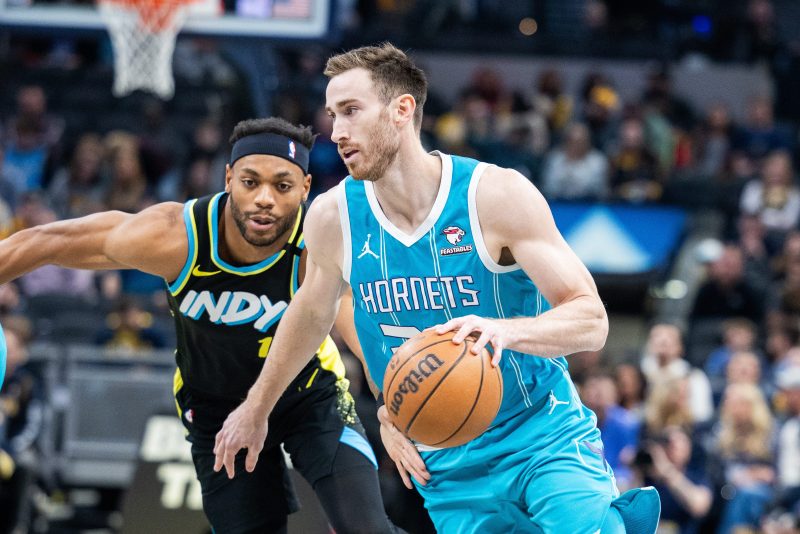The biggest name that moved at Thursday’s NBA trade deadline was Gordon Hayward, a former All-Star who’s now a role player.
No offense to Hayward. He’s a quality player and going from the rebuilding Charlotte Hornets to the contending Oklahoma City Thunder makes him important in the Western Conference title chase.
But this year’s trade deadline lacked the fireworks of the 2023 trade deadline when Kyrie Irving and Kevin Durant were traded from the Brooklyn Nets, the Los Angeles Lakers reshuffled their roster, acquiring D’Angelo Russell and Rui Hachimura among others, and the Minnesota Timberwolves added veteran Mike Conley.
The biggest names discussed in potential trades ahead of Thursday’s deadline – Dejounte Murray, Kyle Kuzma, Andrew Wiggins – remained put with teams unable to strike deals.
Here’s why it was a tempered NBA trade deadline:
The price of doing business was too high
In trades involving Rudy Gobert from Utah to Minnesota and Kevin Durant from Brooklyn to Phoenix, multiple first-round picks were given up to acquire All-Star caliber players. That set the market, unrealistically so, but as Lakers vice president of basketball operations Rob Pelinka said after he was unable to reach a trade deadline deal, “the market is the market.”
Chatter was that the Washington Wizards wanted two first-round picks for Kuzma, and while the Lakers and Atlanta Hawks engaged multiple times on a potential deal that would send Murray to the Lakers, Atlanta is trying to recoup draft picks they gave up to get Murray from San Antonio. The Lakers, who had just one first-round pick to trade, didn’t have the draft capital to meet the Hawks’ demands.
Teams want to remain competitive
Let’s take the Chicago Bulls. They are 25-27, in ninth place in the East and with a chance to make the postseason play-in and even crack the top six for a guaranteed playoff spot. They could have traded DeMar DeRozan, Alex Caruso and/or Nik Vucevic.
But they didn’t.
‘We want to stay competitive,’ Bulls executive vice president of basketball operations Arturas Karnisovas told reporters Thursday. ‘We have an obligation to this organization and to this fanbase and to this city to stay competitive and compete for the playoffs. And that’s what we are doing.’
That doesn’t mean the Bulls will compete for a title. But in an Eastern Conference that has parity, injuries and teams in flux, there are pathways to some success.
There isn’t an appetite for a long, painful rebuilding process.
All-NBA caliber players weren’t available via trade
Teams simply didn’t see a player out there who was available in a trade, worth multiple first-round picks and could make a team a title contender. They’re going to wait until after the season and see how those picks can be used at the draft for that kind of player. That’s the Lakers’ plan.
New collective bargaining agreement has an impact
Without getting too deep into the salary cap weeds, the new 2023 collective bargaining agreement between the NBA and National Basketball Players Association has made some trades more difficult to execute.
The new luxury tax rates starting in 2025-26 are more onerous for teams $10 million or more over the luxury tax line. Instead of paying $2.50 for every dollar over the luxury tax line between $10 million and $14.99 million, teams will pay $3.50 and instead of paying $3.25 for every dollar over the luxury tax line between $15 million and $19.99 million, teams will pay $4.25. For repeat tax teams – those teams that pay a luxury tax in three of the previous four seasons – the tax grows even higher.
ESPN front office insider Bobby Marks used this example for last season’s Golden State Warriors. Under the new tax rates, instead of a $163 million tax payment, it would have been nearly $220 million. They would have paid almost $60 million more. It’s enough to give a franchise like the Warriors reason to reconsider that kind of spending.
Plus, teams approximately $7 million over the luxury tax line will have restrictions on their ability to build a roster, limiting what they could do in trades and the use of exceptions to the salary cap. Like all new CBAs, teams are cautious until they fully understand the ramifications.

